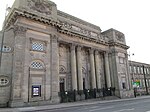Pinnox branch
The Pinnox railway branch officially called the Spur line ran from Pinnox Junction to Tunstall Junction which was located just south of Tunstall railway station. The line was the lower of the two branch lines at Tunstall.The Pinnox branch was connected to a nearby Colliery via the use of a private mineral line.The Pinnox branch was originally constructed as a mineral line between Longport and Tunstall. The line after leaving the main line at Longport Junction ran past Westport Lake on an embankment before passing under Davenport Road and Westport Road. The branch passed the side of what is now Co-operative Academy at Brownhill. The junction with the Potteries Loop Line was at Pinnox Junction, Tunstall.
Excerpt from the Wikipedia article Pinnox branch (License: CC BY-SA 3.0, Authors).Pinnox branch
Scotia Road, Stoke-on-Trent Longport
Geographical coordinates (GPS) Address Nearby Places Show on map
Geographical coordinates (GPS)
| Latitude | Longitude |
|---|---|
| N 53.053745 ° | E -2.202179 ° |
Address
Tunstall Junction
Scotia Road
ST6 4EZ Stoke-on-Trent, Longport
England, United Kingdom
Open on Google Maps









